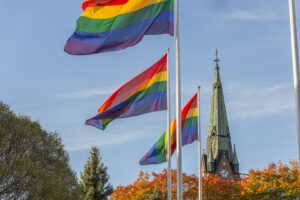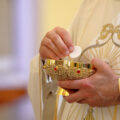Commemorating religious homophobia?
Commemorating religious homophobia?
Christian churches have a history of homophobia. Clémence Sauty asks how churches can commemorate their recent anti-LGBTQ+ past.
This weekly comment was written by Clémence Sauty and reflects her personal analyses and opinions, rather than those of EARS.
Disrupting the religious narrative on LGBTQ+ people
On the occasion of the 2021 Berlin pride celebration, protestant Bishop Christian Stäblein gave an unusual speech. In the name of the Landeskirche Berlin, Brandenburg, and Silesian Upper Lusatia (EKBO[1]), he acknowledged that the Protestant Church was guilty of systematic discrimination towards LGBTQ+ people. He then explained why his Church begged for forgiveness.[2]
This speech was historic on many accounts. One of the reasons it was groundbreaking is that it was the first time that a Christian church voluntarily reflected on its relationship with LGBTQ+ people and publicly commemorated religious homophobia as a thing of the past. Until then, the wrongs of religious institutions were tackled from the outside. Analysts used to ask: “How far should governments be able to interfere in churches’ (mis)treatment of LGBTQ+ people?” and “Is religious homophobia still punishable by the law, if it stems from a queer person of faith?”
Stäblein’s speech does not merely aim at complying with legal or political standards of justice. It aims to conform to an autonomous Christian notion of justice. This implies that the church not only begged queer people and wider German society for forgiveness. It also apologised to God.
Facing a history of homophobia and transphobia
This speech was based on historical science. The research methodology is detailed in Stäblein’s speech:
“The process of documenting the church’s history of harm against queer people is not complete (…). The church subjected queer people to abusive questioning and dismissed them from church employment. Congregations withheld respect and recognition from members of the church living in same-sex relationships. Church leadership demanded of queer people that they live in “celibacy”, “asceticism”, “abstinence”, or “decency”, or demanded that they keep silent about their sexuality. These actions and their consequences were violations of people serving or seeking to serve in the church (…). The biographical catastrophes that resulted from these practices were rarely documented. Our understanding of the lived reality of lesbian church members is particularly poor, and here, more research is urgently required.”[3]
In an interview for EARS , French historian Anthony Favier presented his personal work of exploring the French Christian homophobic phenomena. He explained how and why he documented so-called ‘conversion therapies’ within Christianity. How does such historical research allow for restorative justice?[4]
Gaining awareness of religious abuse
Restorative justice promotes the dignity of all parties, victims, and offenders. It aims to repair harm by providing an opportunity for all stakeholders to take responsibility for what happened, communicate about it, and address their needs. There should be no domination or discrimination in the process.[5] This approach to justice is arguably more likely to prevent transgressors from re-offending, while also providing a greater sense of rehabilitation to the victims.[6]
Restorative justice does not necessarily rely on law and jurisdiction. It does, however, require a critical approach to one’s history.
The EKBO’s initiative to document its homophobic and transphobic past and to beg for forgiveness is an example of justice through restoration. Such edifying dialogues have also been held in the Roman Catholic Church on various other issues. Jean Paul II acknowledged many crimes committed or supported by the Church. For example, he apologised to God for slavery in Goree Island in 1992.[7] He also apologised to God for the slaughter of Serbian people in Banja Luka in 2003.[8] In 2012, he apologised to God for “the violence of the crusades,” for “the Inquisition,” and for “the contempt, hostility and guilty silence of the church towards the Jews.”[9]
Commemorating the recent past
These declarations, however, were sometimes exclusively addressed to God. Also, other current issues seem to not receive the same treatment. Recently, after the massacre of indigenous children by Catholic colonisers was discovered, Pope Francis refused to comply with Canadian requests that the Church ask for forgiveness. In contrast, he responded to Mexican calls to apologise for Conquistador’s violence towards indigenous people on pretence of evangelisation.[10]
Restorative justice requires stakeholders to still be alive. Yet, it seems to be much harder for Christian authorities to reflect on their recent history. This may be why Pope Francis has not yet asked for forgiveness after an independent report found that 330,000 children had been raped or sexually assaulted in France by clergy members in the last 70 years.[11] [12]
Still, restorative justice efforts can take other forms. As required by the report on sexual abuse within French Catholicism, a memorial site is planned to be built in the city of Lourdes. Catholic Bishop Mgr Batut explains that this place will maintain the communication between all stakeholders:
“It would not only be just for commemoration, there would be archives to consult, exhibitions… [The aim is] to learn through these dramas, about the right pastoral relationship, and to help the generations to come to not become naive again regarding the proximity of power relations and sexuality.”
Besides, a day of prayer for the “victims of sexual violence and assault, and the victims of abuses of power” will be held in French Catholic communities every Lent.[13]
What about commemorating religious homophobia?
There can be no restoration without a critical investigation of one’s history. But how long does it take for recent events to become history? The religious condemnation of and disregard for LGBTQ+ people is as historic as can be, lasting from time immemorial.[14]
In France, this took a specific turn during the 2010s as marriage became authorised to both straight and queer couples. Almost ten years after the law passed, Christians who massively denigrated the lives of queer people are still discovering[15] [16] that they caused harm.[17] It is no surprise, then, that the groundbreaking realisation of the EKBO went rather unnoticed within European Christianity.
Restorative justice is history in the making. Justice cannot be done when denying the facts. For the time being, most Christian churches seem to be in great disbelief when confronted with their own history of homophobia and transphobia. Restorative justice may not be conceivable yet. Still, such a thing as a Restorative church is possible.[18]
This weekly comment was written by Clémence Sauty and reflects her personal analyses and opinions, rather than those of EARS.
Interested in similar topics? Go to our Dashboard and receive free updates.
[1] Evangelische Kirche Berlin-Brandenburg-schlesische Oberlausitz – Wikipedia
[2] Bitte um Vergebung: Erklärung der Landeskirche zur Schuld an queeren Menschen
[3] Bitte um Vergebung: Erklärung der Landeskirche zur Schuld an queeren Menschen
[5] Justice/Criminal/Restorative Justice
[6] restorative justice: the evidence
[7] Pope Visits Slave Isle, Asks Forgiveness
[8] Jean Paul II demande pardon pour les crimes catholiques
[9] Jean-Paul II demande pardon pour les péchés de l’église – Archive INA
[10] Le pape demande « pardon » pour les « erreurs » commises au Mexique lors la conquête de l’Amérique
[11] Sexual Violence in the Catholic Church France 1950 – 2020 Summary of the Final Report Independent Commission on Sexual Abuse
[12] Abus dans l’Église : la « justice restaurative », une voie de réconciliation pour l’Église ?
[13] Abus sexuels, quels gestes de l’Église pour reconnaître la souffrance des victimes ?
[14] Homosexuality and religion
[15] « Moi, je ne voulais pas insulter les gens » : des enfants de La Manif pour tous face au souvenir des défilés
[16] https://www.youtube.com/watch?v=UM4MJD0g_5E&t=1s
[17] Ca y est, t’es lesbienne, tu te crois un homme Mariage pour tous, cela veut dire que je pourrai me marier avec mon chien #LesG






